Effects of the Feeding Solution Composition on a Reductive/Oxidative Sequential Bioelectrochemical Process for Perchloroethylene Removal
Abstract
1. Introduction
2. Materials and Methods
2.1. Sequential Bioelectrochemical Process Operation
2.2. Analytical Methods
2.3. D. mccartyi Quantification
2.4. Calculations
3. Results
3.1. Continuous Flow Operation of the Sequential Bioelectrochemical Process with the Mineral Medium
3.2. Continuous Flow Operation of the Sequential Bioelectrochemical Process with the Synthetic Groundwater
3.3. Biomarkers Investigation under the Two Operating Periods
4. Conclusions
Author Contributions
Funding
Institutional Review Board Statement
Informed Consent Statement
Data Availability Statement
Acknowledgments
Conflicts of Interest
References
- Majone, M.; Verdini, R.; Aulenta, F.; Rossetti, S.; Tandoi, V.; Kalogerakis, N.; Agathos, S.; Puig, S.; Zanaroli, G.; Fava, F. In situ groundwater and sediment bioremediation: Barriers and perspectives at European contaminated sites. New Biotechnol. 2015, 32, 133–146. [Google Scholar] [CrossRef]
- Moran, M.J.; Zogorski, J.S.; Squillace, P.J. Chlorinated Solvents in Groundwater of the United States. Environ. Sci. Technol. 2007, 41, 74–81. [Google Scholar] [CrossRef]
- Dolinová, I.; Štrojsová, M.; Černík, M.; Němeček, J.; Macháčková, J.; Ševců, A. Microbial degradation of chloroethenes: A review. Environ. Sci. Pollut. Res. 2017, 24, 13262–13283. [Google Scholar] [CrossRef] [PubMed]
- Mohn, W.W.; Tiedje, J.M. Microbial reductive dehalogenation. Microbiol. Rev. 1992, 56, 482–507. [Google Scholar] [CrossRef] [PubMed]
- Seshadri, R.; Adrian, L.; Fouts, D.E.; Eisen, J.A.; Phillippy, A.M.; Methe, B.A.; Ward, N.L.; Nelson, W.C.; Deboy, R.T.; Khouri, H.M.; et al. Genome Sequence of the PCE-Dechlorinating Bacterium Dehalococcoides ethenogenes. Science 2005, 307, 105–108. [Google Scholar] [CrossRef]
- Saiyari, D.M.; Chuang, H.-P.; Senoro, D.B.; Lin, T.-F.; Whang, L.-M.; Chiu, Y.-T.; Chen, Y.-H. A review in the current developments of genus Dehalococcoides, its consortia and kinetics for bioremediation options of contaminated groundwater. Sustain. Environ. Res. 2018, 28, 149–157. [Google Scholar] [CrossRef]
- Molenda, O.; Jácome, L.A.P.; Cao, X.; Nesbø, C.L.; Tang, S.; Morson, N.; Patron, J.; Lomheim, L.; Wishart, D.S.; Edwards, E.A. Insights into origins and function of the unexplored majority of the reductive dehalogenase gene family as a result of genome assembly and ortholog group classification. Environ. Sci. Processes Impacts 2020, 22, 663–678. [Google Scholar] [CrossRef] [PubMed]
- Matturro, B.; Heavner, G.L.; Richardson, R.E.; Rossetti, S. Quantitative estimation of Dehalococcoides mccartyi at laboratory and field scale: Comparative study between CARD-FISH and Real Time PCR. J. Microb. Methods 2013, 93, 127–133. [Google Scholar] [CrossRef] [PubMed]
- Matturro, B.; Tandoi, V.; Rossetti, S. Different activity levels of Dehalococcoides mccartyi revealed by FISH and CARD-FISH under non-steady and pseudo-steady state conditions. New Biotechnol. 2013, 30, 756–762. [Google Scholar] [CrossRef] [PubMed]
- Nam, S.-H.; An, Y.-J. Assessing the ecotoxicity of vinyl chloride using green alga P. subcapitata, nematode C. elegans, and the SOS chromotest in a closed system without headspace. Sci. Total Environ. 2010, 408, 3148–3152. [Google Scholar] [CrossRef] [PubMed]
- Koziollek, P.; Bryniok, D.; Knackmuss, H.-J. Ethene as an auxiliary substrate for the cooxidation of cis-1,2-dichloroethene and vinyl chloride. Arch. Microbiol. 1999, 172, 240–246. [Google Scholar] [CrossRef] [PubMed]
- Long, J.L.; Stensel, H.D.; Ferguson, J.F.; Strand, S.E.; Ongerth, J.E. Anaerobic and Aerobic Treatment of Chlorinated Aliphatic Compounds. J. Environ. Eng. 1993, 119, 300–320. [Google Scholar] [CrossRef]
- Frascari, D.; Zanaroli, G.; Danko, A.S. In situ aerobic cometabolism of chlorinated solvents: A review. J. Hazard. Mater. 2015, 283, 382–399. [Google Scholar] [CrossRef]
- Freedman, D.L.; Danko, A.S.; Verce, M.F. Substrate interactions during aerobic biodegradation of methane, ethene, vinyl chloride and 1,2-dichloroethenes. Water Sci. Technol. 2001, 43, 333–340. [Google Scholar] [CrossRef] [PubMed]
- Noell Alan, L. Estimation of Sequential Degradation Rate Coefficients for Chlorinated Ethenes. Pract. Period. Hazard. ToxicRadioact. Waste Manag. 2009, 13, 35–44. [Google Scholar] [CrossRef]
- Morkin, M.; Devlin, J.F.; Barker, J.F.; Butler, B.J. In situ sequential treatment of a mixed contaminant plume. J. Contam. Hydrol. 2000, 45, 283–302. [Google Scholar] [CrossRef]
- Devlin, J.F.; Katic, D.; Barker, J.F. In situ sequenced bioremediation of mixed contaminants in groundwater. J. Contam. Hydrol. 2004, 69, 233–261. [Google Scholar] [CrossRef]
- Aulenta, F.; Canosa, A.; Reale, P.; Rossetti, S.; Panero, S.; Majone, M. Microbial reductive dechlorination of trichloroethene to ethene with electrodes serving as electron donors without the external addition of redox mediators. Biotechnol. Bioeng. 2009, 103, 85–91. [Google Scholar] [CrossRef] [PubMed]
- Gregory, K.B.; Bond, D.R.; Lovley, D.R. Graphite electrodes as electron donors for anaerobic respiration. Environ. Microbiol. 2004, 6, 596–604. [Google Scholar] [CrossRef]
- Wang, X.; Aulenta, F.; Puig, S.; Esteve-Núñez, A.; He, Y.; Mu, Y.; Rabaey, K. Microbial electrochemistry for bioremediation. Environ. Sci. Ecotechnol. 2020, 1, 100013. [Google Scholar] [CrossRef]
- Palma, E.; Daghio, M.; Franzetti, A.; Petrangeli Papini, M.; Aulenta, F. The bioelectric well: A novel approach for in situ treatment of hydrocarbon-contaminated groundwater. Microb. Biotechnol. 2018, 11, 112–118. [Google Scholar] [CrossRef] [PubMed]
- Lai, A.; Aulenta, F.; Mingazzini, M.; Palumbo, M.T.; Papini, M.P.; Verdini, R.; Majone, M. Bioelectrochemical approach for reductive and oxidative dechlorination of chlorinated aliphatic hydrocarbons (CAHs). Chemosphere 2017, 169, 351–360. [Google Scholar] [CrossRef] [PubMed]
- Zeppilli, M.; Dell’Armi, E.; Cristiani, L.; Petrangeli Papini, M.; Majone, M. Reductive/Oxidative Sequential Bioelectrochemical Process for Perchloroethylene Removal. Water 2019, 11, 2579. [Google Scholar] [CrossRef]
- Zeppilli, M.; Matturro, B.; Dell’Armi, E.; Cristiani, L.; Papini, M.P.; Rossetti, S.; Majone, M. Reductive/oxidative sequential bioelectrochemical process for Perchloroethylene (PCE) removal: Effect of the applied reductive potential and microbial community characterization. J. Environ. Chem. Eng. 2021, 9, 104657. [Google Scholar] [CrossRef]
- Lai, A.; Verdini, R.; Aulenta, F.; Majone, M. Influence of nitrate and sulfate reduction in the bioelectrochemically assisted dechlorination of cis-DCE. Chemosphere 2015, 125, 147–154. [Google Scholar] [CrossRef]
- Gossett, J.M. Measurement of Henry’s law constants for C1 and C2 chlorinated hydrocarbons. Environ. Sci. Technol. 1987, 21, 202–208. [Google Scholar] [CrossRef]
- Zeppilli, M.; Simoni, M.; Paiano, P.; Majone, M. Two-side cathode microbial electrolysis cell for nutrients recovery and biogas upgrading. Chem. Eng. J. 2019, 370, 466–476. [Google Scholar] [CrossRef]
- Lalaurette, E.; Thammannagowda, S.; Mohagheghi, A.; Maness, P.-C.; Logan, B.E. Hydrogen production from cellulose in a two-stage process combining fermentation and electrohydrogenesis. Int. J. Hydrog. Energy 2009, 34, 6201–6210. [Google Scholar] [CrossRef]
- Aulenta, F.; Verdini, R.; Zeppilli, M.; Zanaroli, G.; Fava, F.; Rossetti, S.; Majone, M. Electrochemical stimulation of microbial cis-dichloroethene (cis-DCE) oxidation by an ethene-assimilating culture. New Biotechnol. 2013, 30, 749–755. [Google Scholar] [CrossRef] [PubMed]
- ter Heijne, A.; de Rink, R.; Liu, D.; Klok, J.B.M.; Buisman, C.J.N. Bacteria as an Electron Shuttle for Sulfide Oxidation. Environ. Sci. Technol. Lett. 2018, 5, 495–499. [Google Scholar] [CrossRef] [PubMed]
- Dutta, P.K.; Rabaey, K.; Yuan, Z.; Rozendal, R.A.; Keller, J. Electrochemical sulfide removal and recovery from paper mill anaerobic treatment effluent. Water Res. 2010, 44, 2563–2571. [Google Scholar] [CrossRef]
- Zhan, G.; Zhang, L.; Li, D.; Su, W.; Tao, Y.; Qian, J. Autotrophic nitrogen removal from ammonium at low applied voltage in a single-compartment microbial electrolysis cell. Bioresour Technol 2012, 116, 271–277. [Google Scholar] [CrossRef] [PubMed]
- Watanabe, T.; Hashimoto, S.; Kuroda, M. Simultaneous nitrification and denitrification in a single reactor using bio-electrochemical process. Water Sci. Technol. A J. Int. Assoc. Water Pollut. Res. 2002, 46, 163–169. [Google Scholar] [CrossRef]
- Zeppilli, M.; Paiano, P.; Villano, M.; Majone, M. Anodic vs. cathodic potentiostatic control of a methane producing microbial electrolysis cell aimed at biogas upgrading. Biochem. Eng. J. 2019, 152, 107393. [Google Scholar] [CrossRef]
- Guiot, S.R.; Cimpoia, R.; Kuhn, R.; Alaplantive, A. Electrolytic Methanogenic−Methanotrophic Coupling for Tetrachloroethylene Bioremediation: Proof of Concept. Environ. Sci. Technol. 2008, 42, 3011–3017. [Google Scholar] [CrossRef] [PubMed]
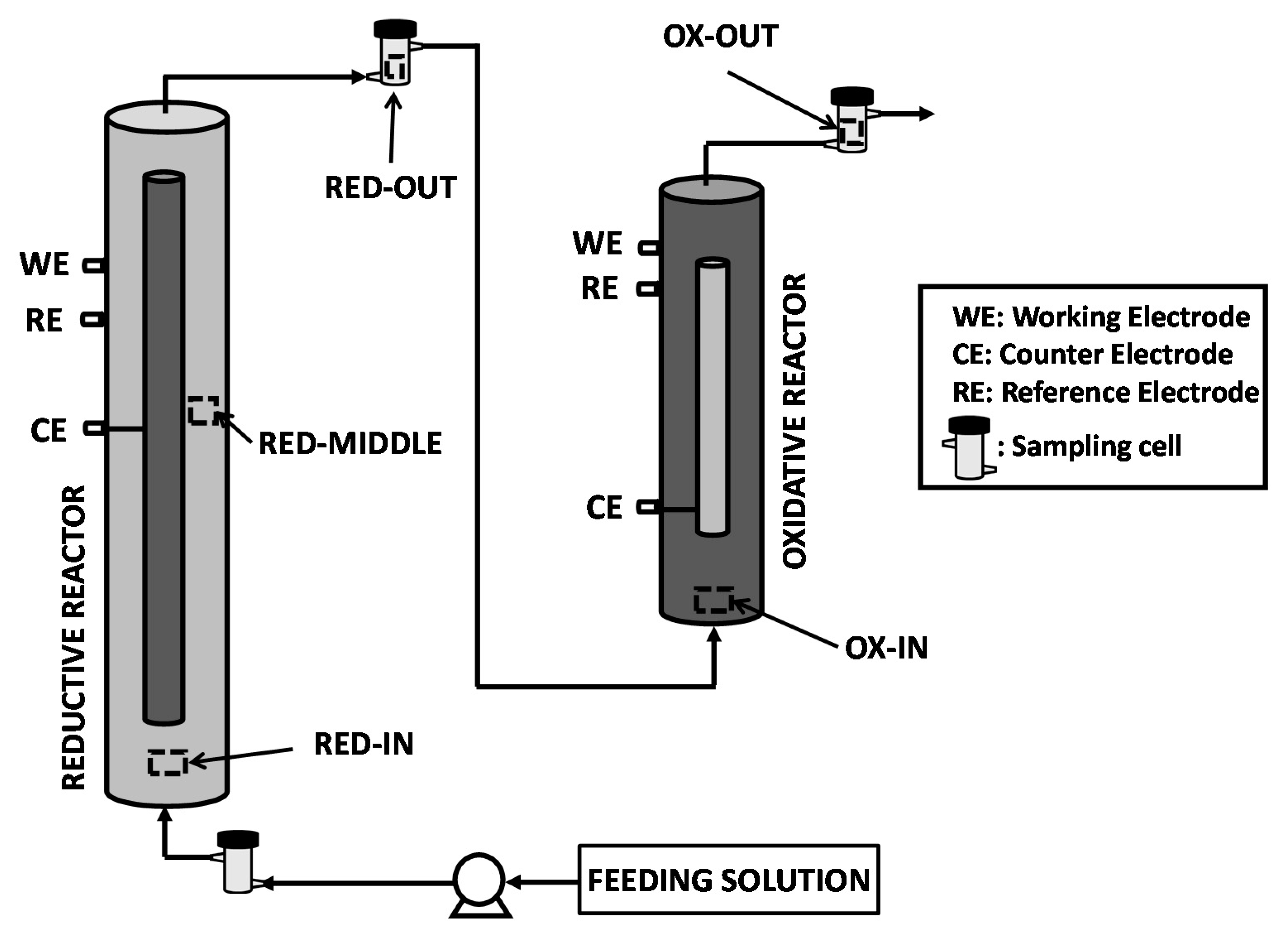
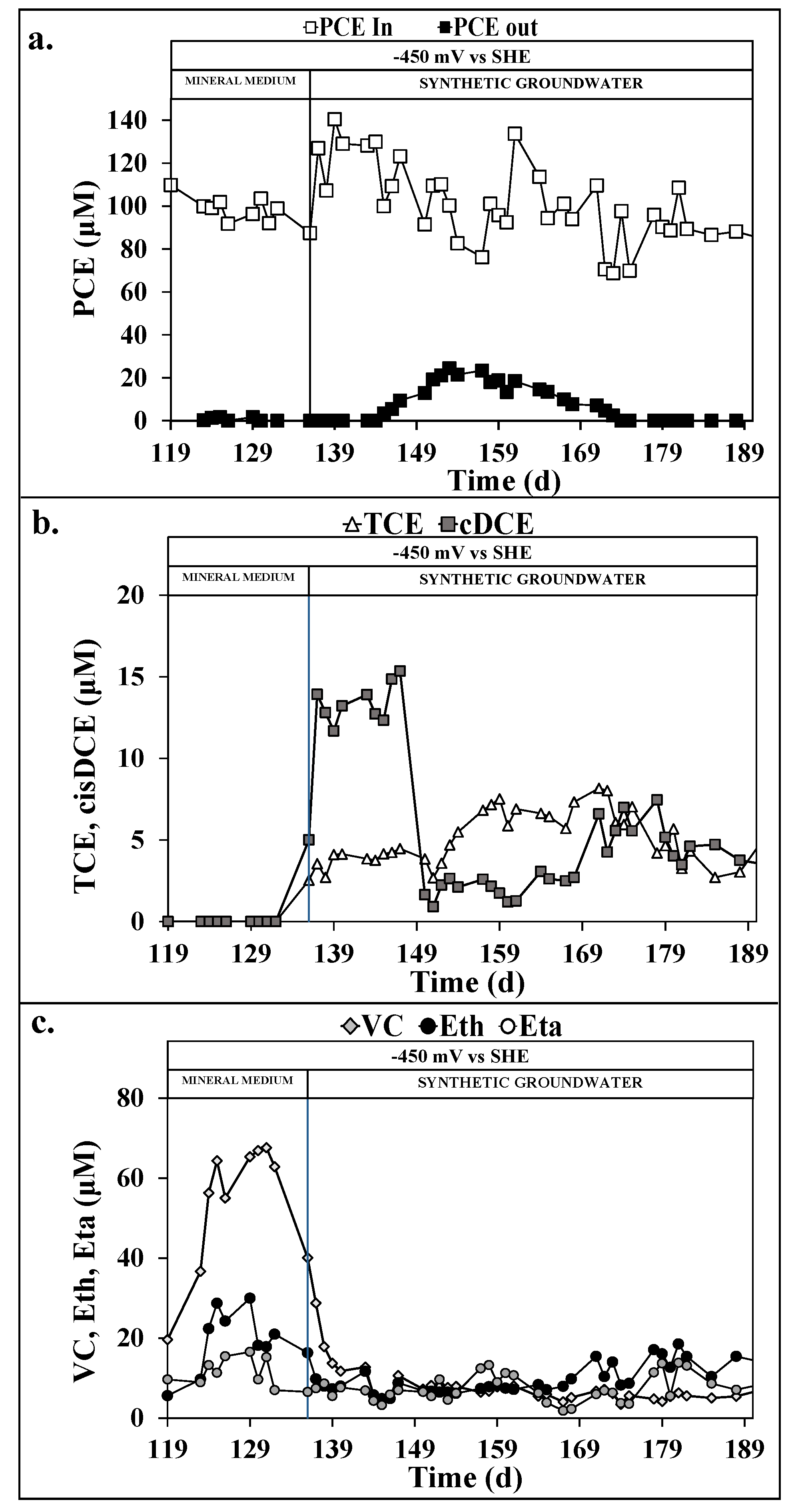
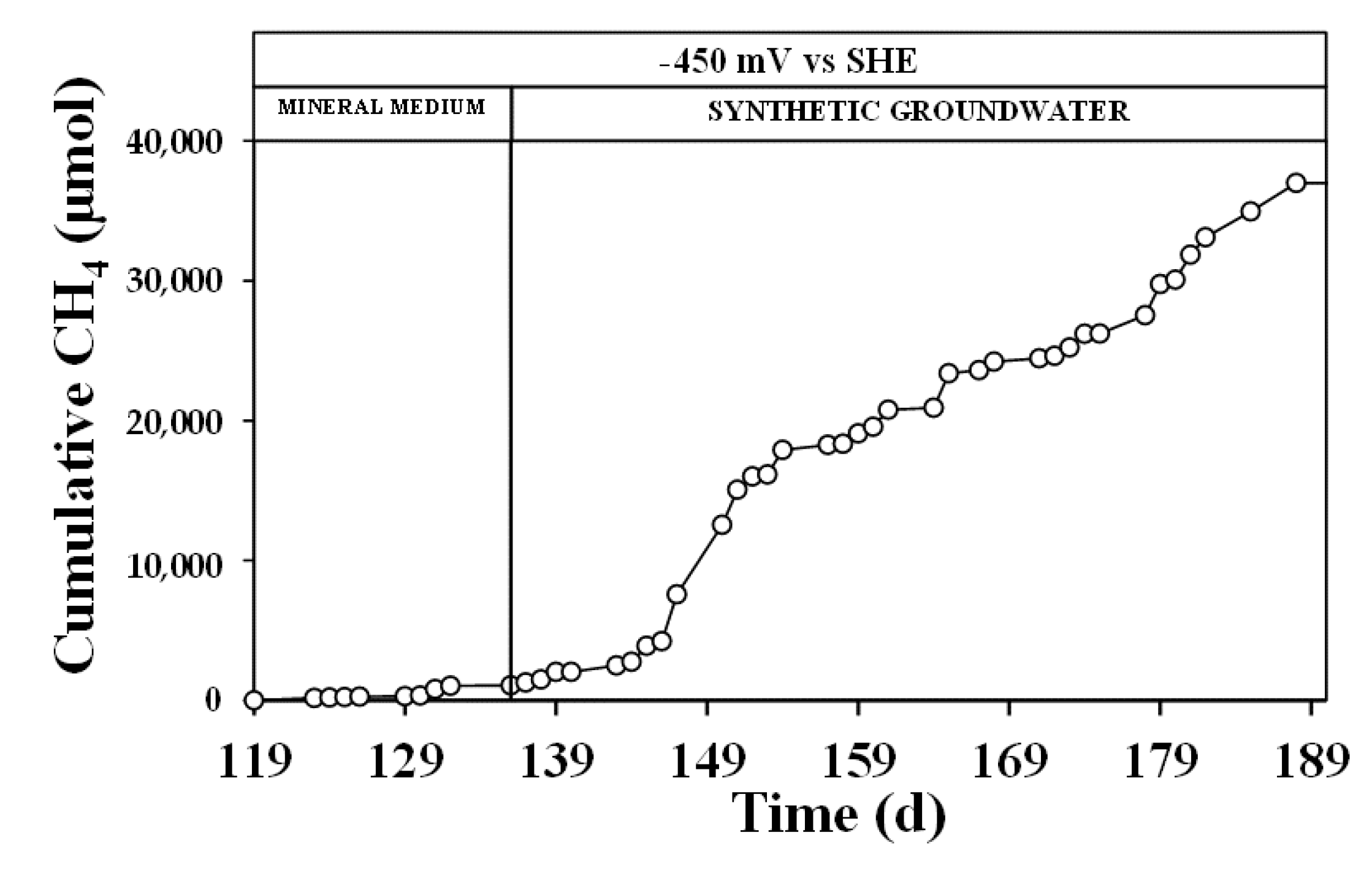
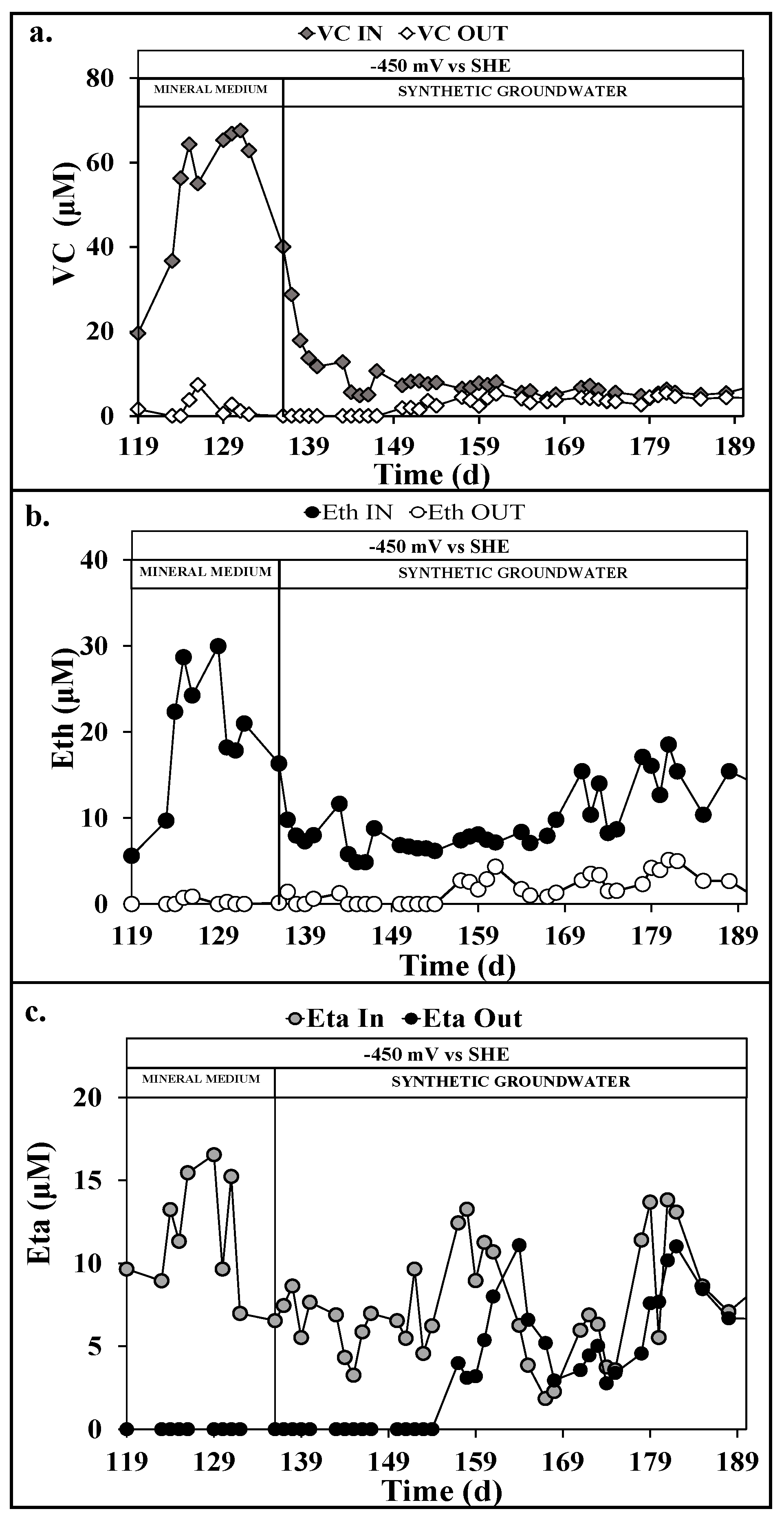
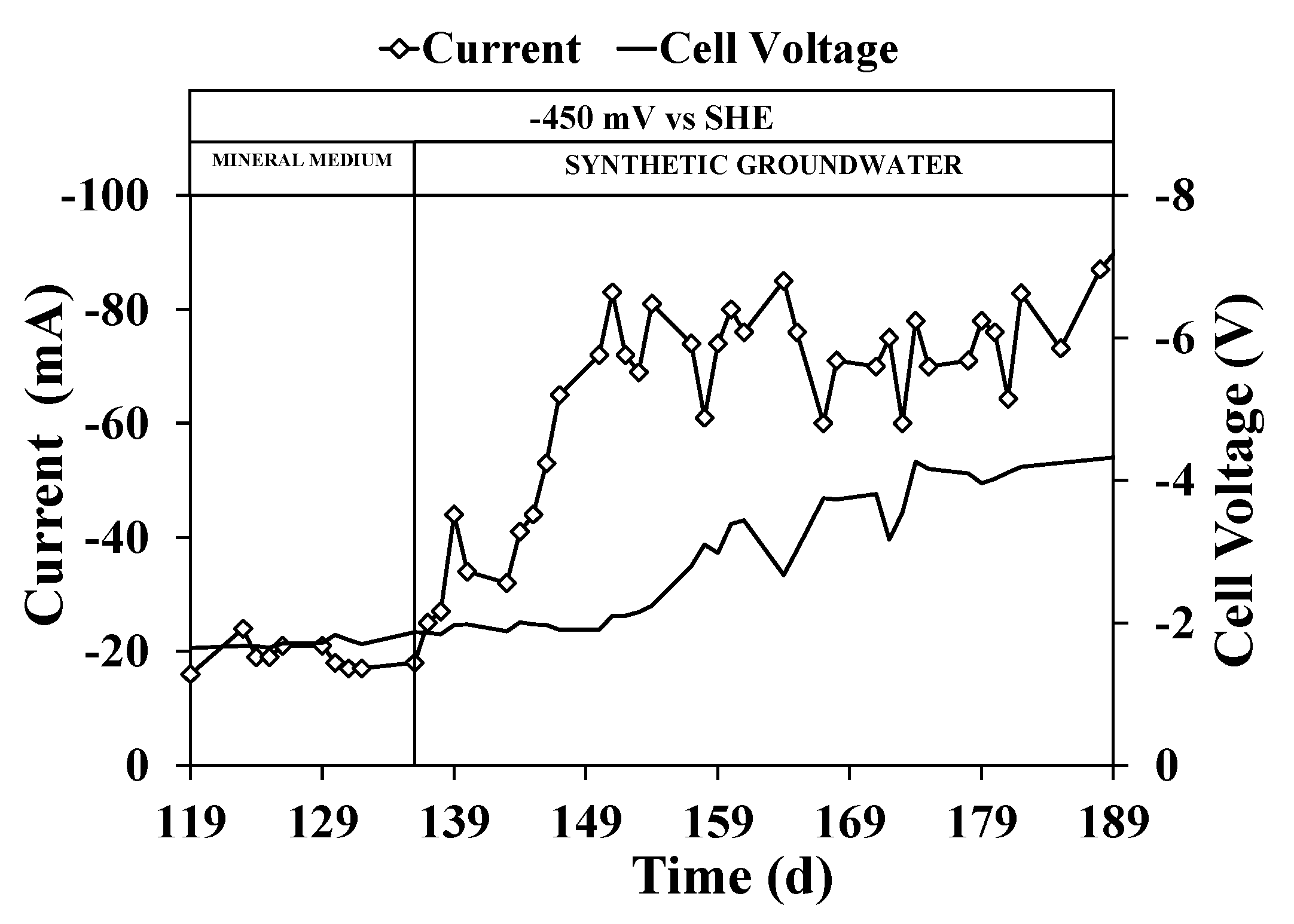
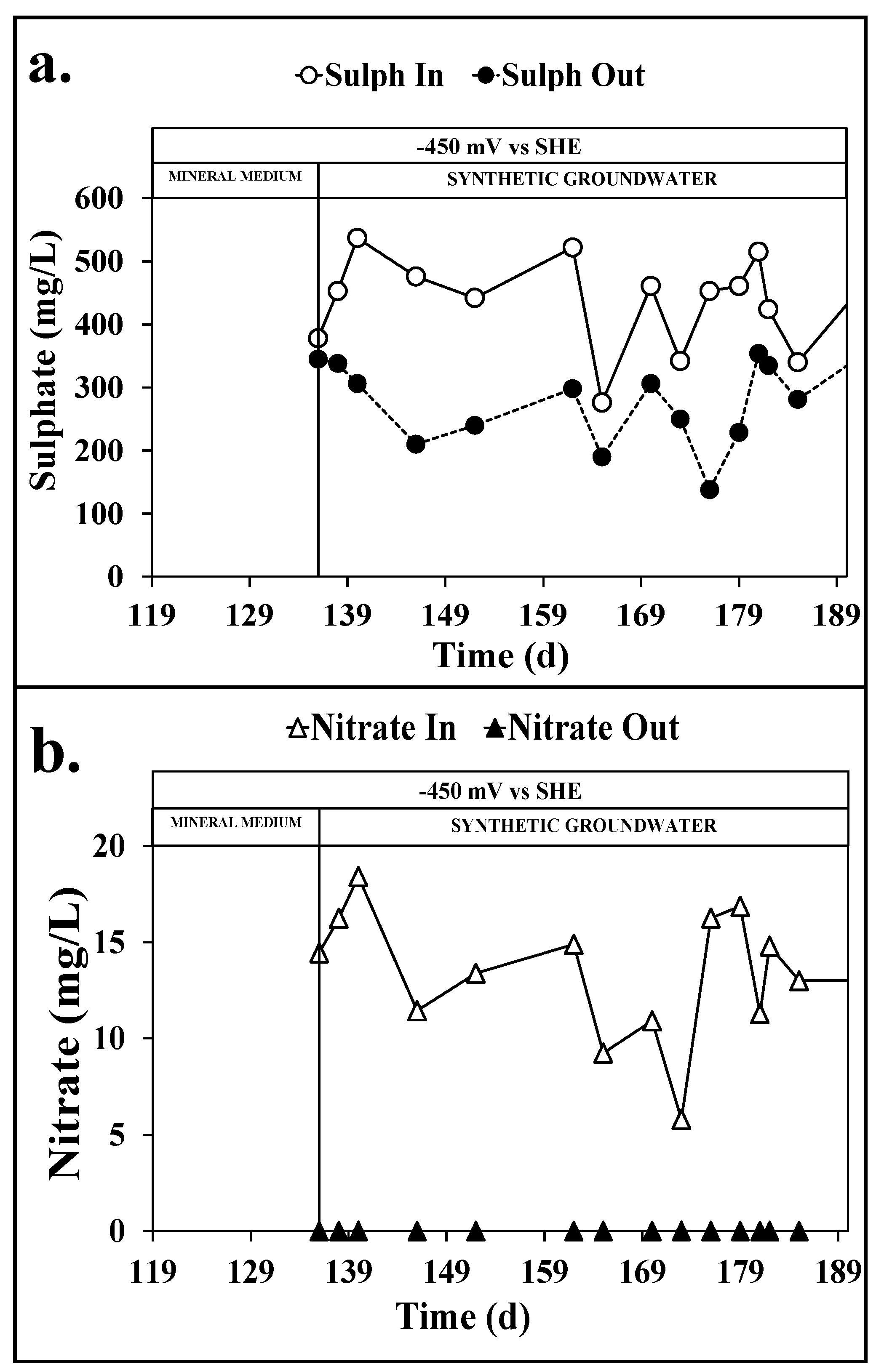
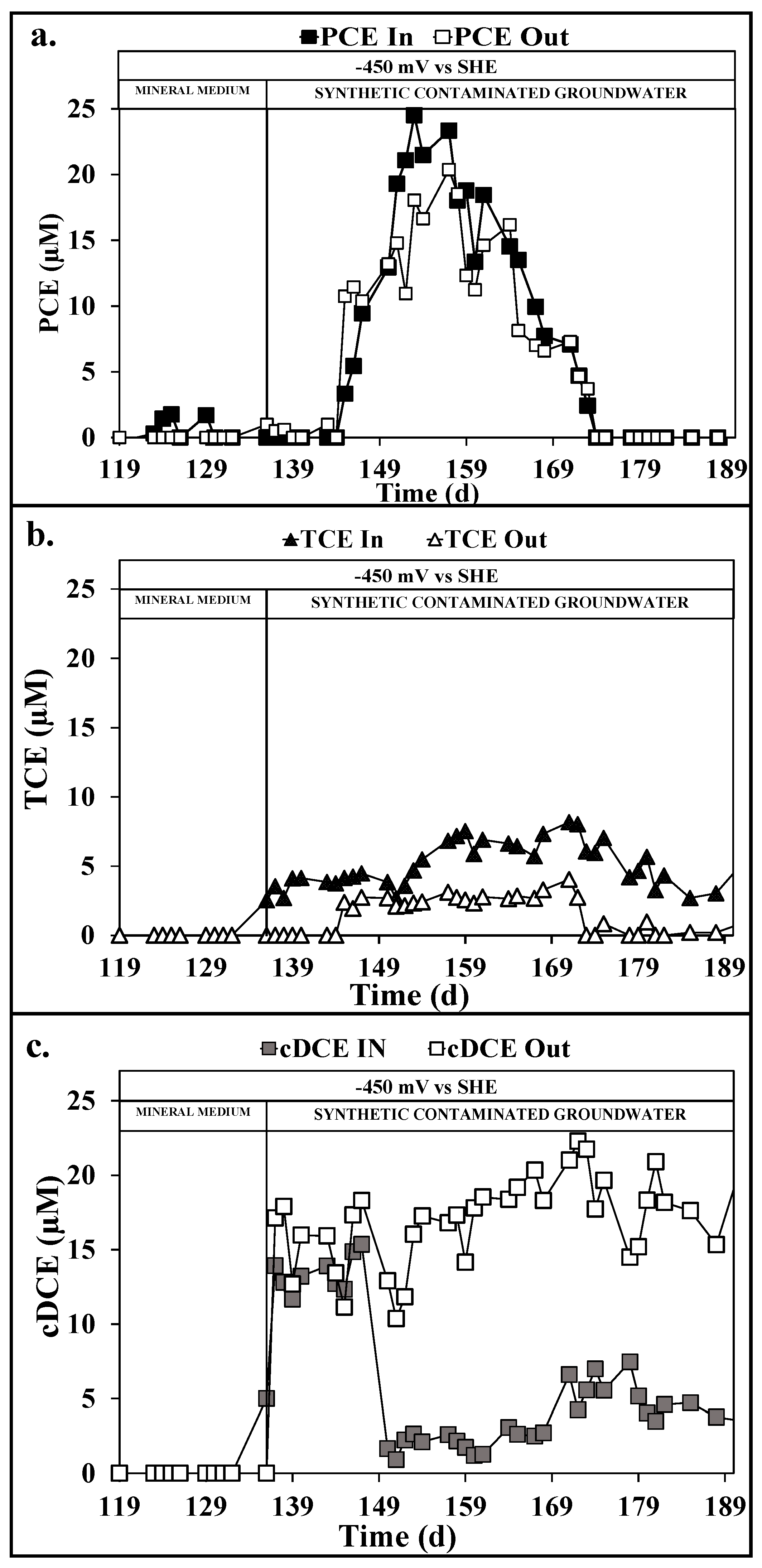
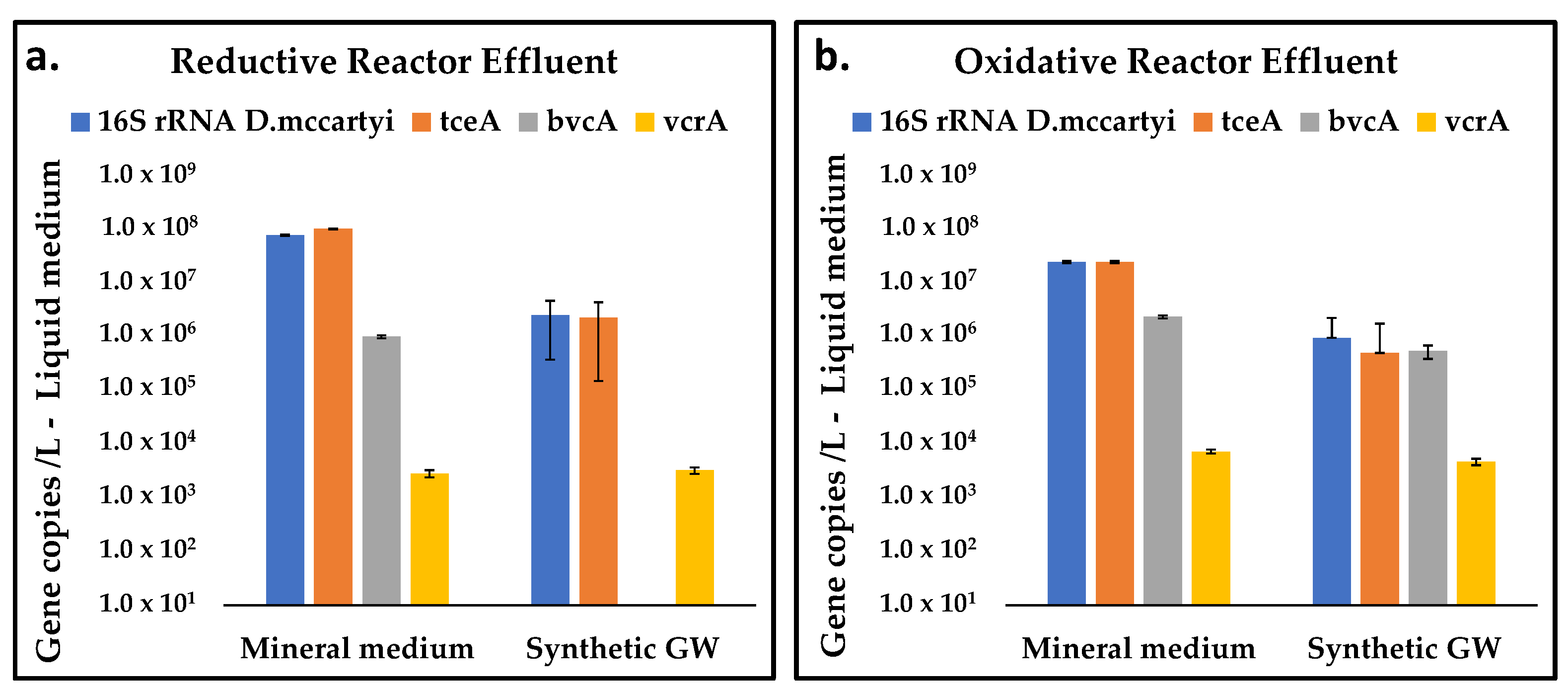
| Compound | Concentration (mg/L) |
|---|---|
| Tap water | - |
| Na2SO4 | 680 |
| NaNO3 | 20 |
| PCE removal (µmol/Ld) | PCEremoval (µmol/Ld) = [PCE]in − [PCE]out × Qliquid/Vreductive |
| Reductive dechlorination rate (RD, µeq/Ld) | RD (µeq/Ld) = Qliquid/Vreductive × [TCE] × 2+[cisDCE] × 4+[VC] × 6+[Eth] × 8+[Eta] × 10 RD (mA) = RD (µeq/Ld) × Vreductive × F/86,400/1000 |
| Methane production rate (rCH4(eq)) | RCH4 (µeq/Ld) = Qliquid/Vreductive × [CH4] × 8 RCH4 (mA) = RCH4 (µeq/Ld) × Vreductive × F/86,400/1000 |
| Sulphate (RD) and Nitrate (RN) removal rate (RS, RN(µeq/Ld)) | RS (µeq/Ld) = Qliquid/Vreductive × [SO4−2]removed × 8 RS (mA) = RS (µeq/Ld) × Vreductive × F/86,400 RN (µeq/Ld) = Qliquid/Vreductive × [NO3-]removed × 5 RN (mA) = RN (µeq/Ld) × Vreductive × F/86,400 |
| Oxidative dechlorination rate (OD, µmol/Ld) | OD(CAHs) (µmol/Ld) = Qliquid/Vreductive × [CAHs]in − [CAHs]out OD(CAHs) (mmolO2/d) = OD(CAHs) (µmol/Ld) × Voxidative × α/1000 αVC = 2.5 αEth = 3 αEta = 3.5 αCH4 = 2 |
| RD Coulombic Efficiency (CERD, %) | CERD = RD (mA)/Iredcutive (mA) × 100 |
| RS Coulombic Efficiency (CERS, %) | CERS = RS (mA)/Iredcutive (mA) × 100 |
| RN Coulombic Efficiency (CERN, %) | CERN = RN (mA)/Iredcutive (mA) × 100 |
| RCH4 Coulombic Efficiency (CECH4, %) | CECH4 = RCH4 (mA)/Iredcutive (mA) × 100 |
| Oxidative coulombic efficiency (CEOD, %) | Ioxidative (mmolO2/d) = Ioxidative (mA)/4/F × 86,400 CEOD = OD(CAHs) (mmolO2/d)/Ioxidative (mmolO2/d) × 100 |
| F = 96,485 C/mol e− 86,400 = s/d Qliquid = liquid flow rate Qgas = gaseous flow rate | |
| Reductive Reactor HRT 3.9 d @ −450 mV vs. SHE | ||
|---|---|---|
| Feeding Solution | Mineral Medium | Synthetic Groundwater |
| PCE removal rate (μmol/Ld) | 26 ± 9 | 22 ± 2 |
| PCE removal efficiency (%) | 99 ± 4 | 95 ± 6 |
| RD Rate (μeq/Ld) | 177 ± | 68 ± 1 |
| Current (mA) | −19 ± 1 | −65 ± 3 |
| RD Coulombic Efficiency (%) | 8 ± 2 | 1 ± 1 |
| Reductive Reactor HRT 3.9 d −450 mV vs. SHE | |
|---|---|
| Coulombic Efficiency RD (%) | 1 ± 1 |
| Coulombic Efficiency Sulphate Reduction (%) | 45 ± 9 |
| Coulombic Efficiency Nitrate Reduction (%) | 4 ± 1 |
| Coulombic Efficiency CH4 (%) | 11 ± 5 |
| Global Coulombic Efficiency (%) | 61 ± 16 |
| 16S rRNA D. mccartyi | tceA | bvcA | vcrA | ||
|---|---|---|---|---|---|
| Mineral Medium | RR * Effluent | 1.30 × 108 | 1.73 × 108 | 1.91 × 106 | 2.01 × 10 3 |
| OR * Effluent | 2.34 × 107 | 2.33 × 107 | 2.23 × 106 | 7.12 × 103 | |
| Synthetic Groundwater | RR * Effluent | 2.92 × 106 | 2.89 × 106 | 0.00 × 101 | 2.89 × 103 |
| OR * Effluent | 9.10 × 105 | 4.76 × 105 | 5.13 × 105 | 4.60 × 103 |
Publisher’s Note: MDPI stays neutral with regard to jurisdictional claims in published maps and institutional affiliations. |
© 2021 by the authors. Licensee MDPI, Basel, Switzerland. This article is an open access article distributed under the terms and conditions of the Creative Commons Attribution (CC BY) license (http://creativecommons.org/licenses/by/4.0/).
Share and Cite
Dell’Armi, E.; Zeppilli, M.; Matturro, B.; Rossetti, S.; Petrangeli Papini, M.; Majone, M. Effects of the Feeding Solution Composition on a Reductive/Oxidative Sequential Bioelectrochemical Process for Perchloroethylene Removal. Processes 2021, 9, 405. https://doi.org/10.3390/pr9030405
Dell’Armi E, Zeppilli M, Matturro B, Rossetti S, Petrangeli Papini M, Majone M. Effects of the Feeding Solution Composition on a Reductive/Oxidative Sequential Bioelectrochemical Process for Perchloroethylene Removal. Processes. 2021; 9(3):405. https://doi.org/10.3390/pr9030405
Chicago/Turabian StyleDell’Armi, Edoardo, Marco Zeppilli, Bruna Matturro, Simona Rossetti, Marco Petrangeli Papini, and Mauro Majone. 2021. "Effects of the Feeding Solution Composition on a Reductive/Oxidative Sequential Bioelectrochemical Process for Perchloroethylene Removal" Processes 9, no. 3: 405. https://doi.org/10.3390/pr9030405
APA StyleDell’Armi, E., Zeppilli, M., Matturro, B., Rossetti, S., Petrangeli Papini, M., & Majone, M. (2021). Effects of the Feeding Solution Composition on a Reductive/Oxidative Sequential Bioelectrochemical Process for Perchloroethylene Removal. Processes, 9(3), 405. https://doi.org/10.3390/pr9030405










